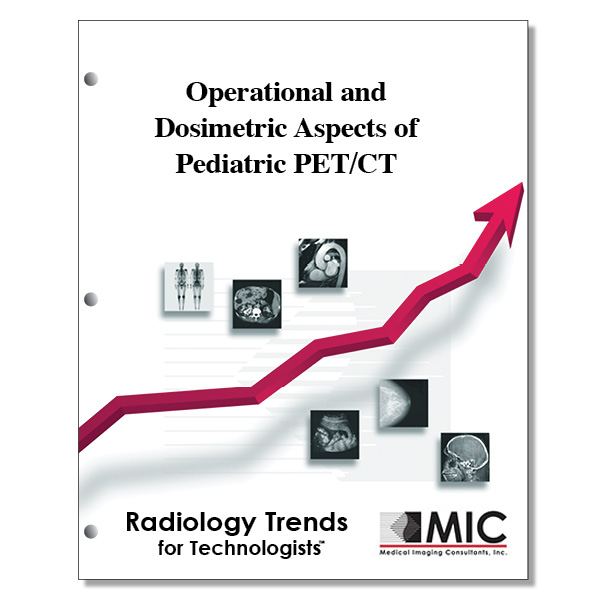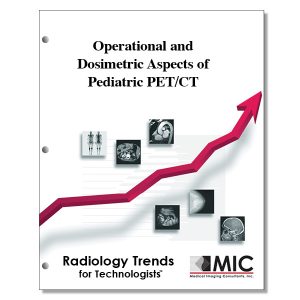

Operational and Dosimetric Aspects of Pediatric PET/CT
A strategy is presented to reduce radiation dose in pediatric PET/CT techniques while combining the PET and diagnostic CT into a single acquisition.
Course ID: Q00526 Category: Radiology Trends for Technologists Modalities: CT, Nuclear Medicine, PET, Radiation Therapy2.0 |
Satisfaction Guarantee |
$24.00
- Targeted CE
- Outline
- Objectives
Targeted CE per ARRT’s Discipline, Category, and Subcategory classification for enrollments starting after January 30, 2024:
[Note: Discipline-specific Targeted CE credits may be less than the total Category A credits approved for this course.]
Computed Tomography: 0.75
Safety: 0.75
Radiation Safety and Dose: 0.75
Nuclear Medicine Technology: 2.00
Image Production: 2.00
Instrumentation: 2.00
Outline
- Introduction
- Basics of CT Dosimetry
- Acquisition of PET/CT
- Practice of Pediatric PET/CT
- Survey of North American Pediatric PET/CT Clinics
- Boston Childrenís Hospital Approach
- Case Study
- Discussion
- Conclusion
Objectives
Upon completion of this course, students will:
- know the pediatric conditions for which PET/CT provides crucial diagnostic and management information
- be familiar with pediatric malignancies which have had their staging and tumor response assessments transformed by PET/CT imaging
- understand the reasoning behind why children are particularly sensitive to potential carcinogenic effects of ionizing radiation
- know the considerations for best practices in pediatric PET/CT imaging
- know the components on which the 3D tissue density map provided by the CT depend
- know the unit of measurement for the x-ray tube current that characterizes the number of electrons striking the anode per second
- understand the principles of x-ray tube voltage in relation to x-ray production and patient dose
- understand CT pitch, the factors that control it, and the effects of changing it
- understand the CT Hounsfield unit and how it is derived
- know the objectives of CT automatic exposure control (AEC)
- be familiar with the various dosimetric parameters used in CT imaging
- know the three uses of the CT portion of a PET/CT examination
- understand the part CT plays in the correction of PET data during image reconstruction
- know the potential advantages of acquiring both diagnostic CT and PET in a single imaging session
- understand the reasoning behind the adjustments to CT data prior to being used for PET attenuation correction
- be familiar with the information which was asked from the surveyed institutions
- be familiar with the breakdown of how the various 19 sites acquired the CT portion of their pediatric PET/CT examinations
- know the primary reason for using automatic kV selection for kV modification in CT
- know the advantages of the Boston Children’s Hospital approach to the CT portion of the PET/CT
- understand the Boston Children’s Hospital approach to the CT portion of the PET/CT
- know the phantom(s) used in the Boston Children’s Hospital phantom experiment
- be familiar with the imaging scenarios considered in the Boston Children’s Hospital phantom experiment
- understand how the various imaging scenarios in the Boston Children’s Hospital phantom experiment provided the 10-year-old phantom patient with reduced radiation dose
- be familiar with the diagnosis and staging of the 13-year-old patient in the article’s case study
- understand the value of having the diagnostic abdomen/pelvis CT as part of the PET/CT
- understand the difference in patient radiation dose between the diagnostic CT and non-diagnostic CT acquisitions of the Boston Children’s Hospital PET/CT protocol
- know the example provided in the article where the acquisition of a separate limited diagnostic CT would be more appropriate than using the Boston Children’s Hospital CT acquisition protocol
- know the best practice approach in pediatric PET/CT imaging
- know a good alternative protocol when using the Boston Children’s Hospital protocol is not an option due to the constraints of a facility’s PET/CT hardware or software
- know the potential reason stated in the article for many sites not utilizing iodinated contrast material with PET/CT and the argument against this reasoning
